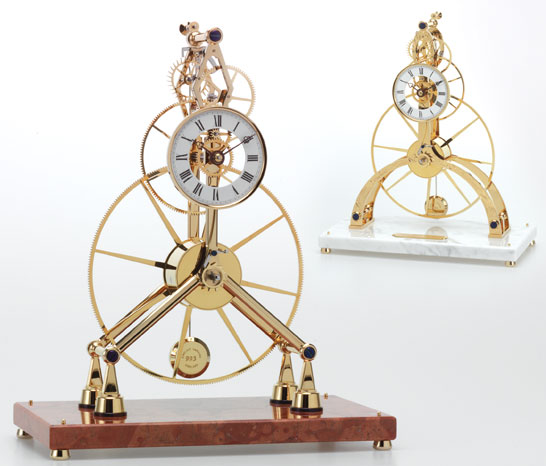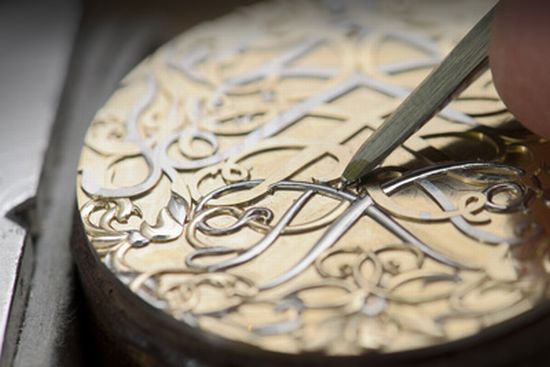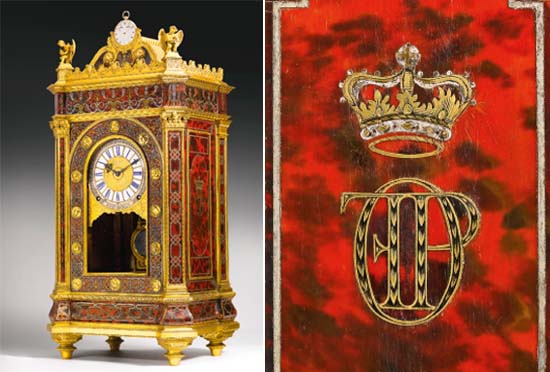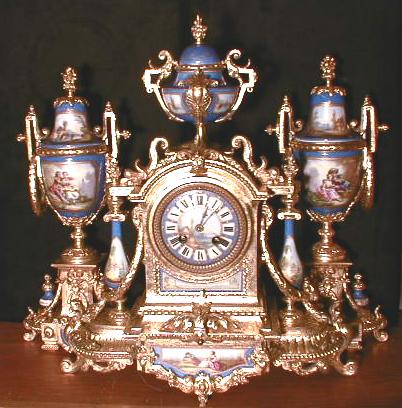Clocks that are collectible frequently have features that make them difficult and expensive to repair, such as a Brocot escapement. French clocks and Atmos clocks are collectible, but they are much more difficult to repair than other clocks and more difficult to keep running. Carriage clocks and Vienna Regulator wall clocks can be very difficult to repair and need repairs more frequently than other clocks. The same is true for grandfather clocks with tubular bells, such as Herschede and Elliott clocks. Mechanical anniversary clocks look simple but many are difficult to keep running.
Most older clocks that are bought used will need repairs because the seller is unlikely to have restored the mechanism, but rather just getting it to run well enough to be able to sell it. I can safely recommend three clocks, the Seth Thomas Ogee 30-hour clock, the Seth Thomas #89 clocks (and similar American clocks with “H” plates), and grandfather clocks with the Hermle 451 series (dated between about 1970 and 1985) mechanisms, though these clocks are abundant and therefore not desired by collectors.
These clocks are reliable and very durable. They are simple and therefore easy to repair. They are affordable to buy. There are many other good and more collectible clocks, but more knowledge and experience is required before buying one. Another problem to consider is that the cost of repair will frequently exceed half the market value of the clock, particularly with wall clocks and mantle clocks (such as the three clocks I recommended above), unless you are repairing them yourself.
Before buying a spring-driven clock, try to wind it to see if it has a broken mainspring. If the key turns and you hear the mainspring slip, the spring has broken at the outer end and there would probably be little or no damage to the gears. If the mainspring is fully wound, there is probably no damage either (exceptions sometimes include carriage clocks and French clocks). If the winding key turns easily and there is no load, the mainspring has broken near the inner end and there would probably be considerable damage to the gears. Be sure that parts are not missing, such as the pendulum or weights (if the clock was designed to have them).
Consider the age of the clock before buying. The older the clock, the more desirable and collectible it is. However, clocks made before about 1870 are usually more difficult to repair because the industry lacked good technology in the machines that were used to manufacture clock parts. Parts were finished and fitted by hand. The parts fit together less accurately than parts in newer clocks, which can create problems during repair. Some of the finest timepieces I have seen, in terms of quality and technology, were made between 1910 and 1950. Newer clocks have very accurately made parts, but manufacturers have increasingly been finding ways to lower production costs, frequently at the expense of quality, which is why I do not like most clocks made after 1985.
What To Look For
Right: A rare and historically important Queen Anne sidereal and mean time ebonised longcase regulator of month duration, by Thomas Tompion & Edward Banger, No. 483, circa 1708/9
Sold for £621,250
July 2003
London, King Street
With clocks, what you see is most definitely not all you get. It is important to look at the entire clock, not just the beautiful case but also the mechanical heart within.
Here’s some quick advice:
Avoid so-called marriages, i.e., clocks whose authentic movement was removed and replaced with another not its own
Always try to buy the best in the price range you can afford (this also makes it easier to trade up at some time for a more expensive and more desirable piece) If you are a beginner, decide early on about the form of the collection (e.g., you may want to specialize in carriage clocks, novelty clocks, 18th century English clocks, etc.)
Prices
Right: A Victorian walnut and brass striking skeleton clock with balance wheel escapement by James Condliff, circa 1850
Sold for £71,700
July 2003
London, King Street
Compared to other collecting fields, prices for antique clocks are relatively modest. A clock by a top maker will generally cost much less than a painting by a top artist of the same period. An 18th century English bracket clock by a good maker can be purchased at auction for less than £10,000 (approximately $15,000).
A collector can start with a French 19th century French decorative mantel clock or a French striking carriage clock from the latter part of the 19th century with a repeat facility or an alarm, which will cost around £600 (or $900).
As is the case with all antiques, rarity and condition are very important and affect price. Christie’s London sold a Queen Anne ebony miniature table clock with pull quarter repeat for more than £350,000 or more than $500,000 (December 2000).
Introduction to clocks
Clocks have been appreciated and treasured since at least the 17th century and, despite their popularity, are available at a wide range of prices. Here we look at what you need to know if you’re thinking of beginning a collection.
The value of a clock depends on its maker, the movement, the case and its condition. Plain carriage clocks are available from about £200, and a late 19th-century long-case from around £800.
Unlike many other types of antiques, clocks are ‘working’ antiques. You can appreciate them for their visual appeal and technical mastery – and they also serve as timekeepers.
If you’re a novice collector thinking of investing in a clock, it’s probably best to buy one in working order. Most clocks can be repaired, but restoring a ‘bargain’ can be a laborious and expensive business, and unless the problem is very straightforward it’s often cheaper in the long run to buy a clock that’s been properly overhauled and restored to working order by a skilled clockmaker.
Most clocks are relatively easy to date and identify because they were signed by their maker on the dial and movement, and records of most makers have survived. A clock’s visual appeal, however, lies largely in its case, which usually reflects the style of furniture of the period.
There are three key elements which you should access before buying a clock: the mechanism, or movement; the dial; and the case.
Movements
The movement consists of a system of brass and steel wheels and gears, known as the train. It’s usually housed between two brass plates.
between two brass plates.
The escapement. This is the part of the movement that controls the speed at which a clock runs.
The verge or balance wheel escapement. The balance wheel escapement was used on lantern clocks until c.1760. The oscillating balance wheel releases the two pallets of ‘flags’ on the vertical bar, which engage the toothed wheel. The verge escapement is similar but has a short pendulum.
The anchor escapement. This was first used in long-cases from c.1670, and became standard for long-cases and brackets. The anchor engages with the teeth of the escape wheel. Clocks with an anchor may have a long or short pendulum.
Pendulums
Weight-driven and spring-driven clocks usually have a pendulum to control the clock’s speed. The pendulum is a brass or steel rod with a metal disc, or bob, at the bottom. Adjusting the position of the bob on the rod alters the timekeeping of the clock.

Dials
A. Chapter ring
B. Subsidiary dial
C. Calendar aperture
D. Applied corner spandrels
E. Winding holes
F. Hour hand
G. Minute hand
H. Dial arch
I. Engraved boss
J. ‘Matted’ centre
The dial is the face of the clock and is attached to the movement by a number of brass ‘feet’. A dial has an important bearing on price. Clocks with replaced dials are much less desirable. There are four main types of dial:
Brass dials. These are the earliest type of dial, used on lantern, bracket and long-case clocks. These have the hours engraved onto a detachable chapter ring.
Painted metal dials. These are found on most clocks after c.1800. They became increasingly elaborate in the 19th century.
Painted wooden dials. These are found on English dial clocks, tavern clocks and continental clocks. If authentic, the wood will show some signs of cracking caused by changes in temperature.
Enamelled metal dials. These are common on carriage clocks and other types of French clock. They’re made from enamel fired on top of thin copper.
Hands. Early clocks only have one hand (for hours), but from c.1660 most have both a minute and an hour hand. Second hands are usually shown on a subsidiary dial. Hands are usually made from blued steel, although gilded brass is found from c.1790. Until c.1740 the hour hand was elaborate, while the minute hand was longer and simpler. Replacement hands are acceptable if they’re in the right style.
Cases. The case houses the dial and the movement. Knowledge of materials and styles is useful in dating a clock and in assessing its value.
Wooden cases. These were introduced in the 17th century. Many cases are covered with thin veneers of wood. The most common woods are ebony, walnut, mahogany and rosewood. Wooden cases may be decorated with marquetry (patterns made from different woods), lacquer, applied metal mounts, brass inlay (on rosewood cases), or a combination of tortoiseshell and brass (boulle work).
Metal cases. Brass is the most common metal: all carriage clocks are brass-cased. Old brass is uneven and shows marks left by the casting process, while modern rolled brass is of uniform thickness. Brass cases may be elaborately engraved or decorated with enamel colours.
Signatures. Most clocks are signed, although a signature isn’t always a guarantee that the clock was made by the maker whose signature it bears. 19th century clocks may be signed by the retailer rather than the maker.
Genuine signatures are usually found in the following places: until 1690, along the bottom of the dial plate; from 1690 to 1720, on the chapter ring; after 1720, on the chapter ring, on the boss in the arch or on an applied plaque.
Bracket clocks
The term bracket clock is used nowadays to describe all clocks with short pendulums and spring-driven mechanisms. They range from simple, solid designs to extremely ornate decorative ones. Despite the name, not all of these clocks stood on wall brackets. They were also placed on tables and mantelpieces, and they’re sometimes called mantel clocks or table clocks.
A brief history
Bracket clocks were made from about 1660. The earliest ones had square brass dials, but by the beginning of the 18th century, arched dials became more common.
The English bracket clocks you’re most likely to come across are those with mahogany veneered cases. Large numbers were produced from the late 18th and early 19th century, mainly in London, and you can still find clocks of this type for about £3,000 to £6,000.
It’s also easy to find French 19th-century clocks, which were made in a wide variety of shapes. Many of these incorporate such lavish decoration that you may need to take a second look before you realise they’re clocks at all.
Early brackets
Early (pre-1700) bracket clocks, such as this one from about 1695, are usually the most valuable. You can generally identify them by their ebony or walnut cases and elaborately decorated square dials.
Regency clocks
You can recognize a bracket clock made in the Regency period as it will usually have a convex dial signed by its maker, simple hands made from brass or blued steel, and a mahogany or rosewood case. A clock like the one shown would be worth about £4,500.
French bracket clocks
Depending on the degree of elaboration, prices for French clocks start at about £500. This one is decorated with a bronze figure of a black woman (representing Africa) and a gilt panther and tortoise and is worth £5,000 or more.
Bracket clock tips
- Movements. Most mahogany brackets originally had a verge escapement (see Introduction to clocks). Many of these were converted to an anchor escapement, but this should not put you off buying.
- Strike/silent lever. The strike/silent lever controls the striking mechanism of the clock and can be used to turn it off without affecting its running.
- Finials. Check all the finials (the ornaments at the corners) match. On many clocks some have been replaced – this is less desirable.
Makers
The value of a clock is greatly increased if it’s signed by a famous maker. The dial and backplate of this clock are signed by Thomas Tompion. Known as the father of English clock making, Tompion is one of the most famous English clock makers and this piece would therefore be worth more than £100,000!
Mahogany brackets

Most mahogany clocks are larger than earlier ebony or walnut ones. The one shown at the top of the page, which dates from about 1785, is of standard size and measures 51cm (20in) high. It would cost about £7,500.
Both elaborate and simple cases were made from mahogany. The 1875 clock here has a fairly simple one, but the clocks illustrated here show some of the more elaborate variations.
Carriage clocks
Few people today would think of packing a carriage clock when they go on a journey, yet this is what they were designed for. They usually have brass cases with handles and many originally came with a leather travelling case. They’re among the least expensive types of antique clocks available. You can buy less elaborate models for about £300 to £600, although quality ones may cost more than £2,000.
French carriage clocks
While a few were made in England, nearly all carriage clocks were made in France during the 19th and early 20th century.
Features to look for are:
- white enamel dial
- black numerals
- stamped mark or signature on the backplate
- eight-day duration
- spring-driven movement with going barrel
- bevelled glass panels
- blued steel hands
Signs of quality:
- engraved case
- panelled cloisonné or porcelain case
- subsidiary dials
Repeat buttons
Some carriage clocks have a repeat button on the top of the case: when the button is pressed the clock repeats the last hour struck. The one at the top of the page was made by Henri Jacot in about 1890 and would be valued at between £900 and £1,800.
Engraved cases
Engraved-case carriages are more valuable than plain ones. Look for elaborate, detailed decoration which covers as much of the case as possible. This one was made by Le Roy & Fils in about 1865 and would cost about £2,000 to £3,000.
Makers
Look out for clocks made by:
- Auguste (French), active from 1840
- Abraham-Louis Breguet (French), 1747 to 1823
- Achille and Louis Brocot (French), active 19th century
- Dejardin (French), active 19th century
- Pierre and Alfred Drocourt (French), 1860 to 1889
- Frodsham family (English), 19th to 20th century
- Paul Garnier (French), 1801 to 1869
- Japy (French), 1772 to early 20th century
- FA Margaine (French), c.1870 to 1912
- E Maurice (French), active 1880s
- James McCabe (English), 19th century
- Soldano (French), c.1855 to 1880
Subsidiary dials
Clocks with subsidiary dials are especially desirable. This English carriage, which is worth about £900, has an alarm dial. Some clocks also have dials showing seconds or the days of the week.
Longcase clocks
Longcases, popularly known as grandfather clocks, are among the most appealing of all antique clocks. Most were made in England between the late 17th and 19th centuries, although lesser numbers were also produced in Europe and America. The standard longcase runs for eight days and has an anchor escapement (see Introduction to clocks).
Value pointers
Like most types of clock, the value of a longcase depends on the quality of the case, movement and dial.
If a clock has an unusual or attractively painted dial, or an elaborate marquetry or lacquered case, it will cost more than a run-of-the-mill version.
Size can also have a bearing on price. Smaller longcases are usually more expensive than larger ones, and for good reason. In the past, rooms had higher ceilings than modern homes, and longcase clocks tended to be designed in proportion. So don’t forget to check that a longcase will fit before you buy it!
Names to look out for
The mahogany clock right, is signed by a Birmingham clock maker named Edward White. Longcases by London makers are usually particularly sought after, especially Thomas Mudge Sr, William Dutton and John Holmes.
Mahogany longcases
Mahogany was used to make longcases from the mid 18th century until the 19th century. Because the one at the top of the page, from 1875, is fairly elaborate it’s worth around £2,000. But you can find simple 19th-century versions from about £1,000.
Parts of a longcase:
- Hands. The hands on most longcases are made from ‘blued’ steel – the metal was heated to create the dark colour.
- Trunk. The centre section of the case has a door which opens to allow you to adjust the pendulum and fit the weights. Longcases were designed to stand against a wall, so the backs are made from unpolished wood.
- Base/plinth. The wood on the base and plinth should match the rest of the case. If it looks different parts may have been replaced and this will reduce the value.
- Finials. Finials (corner ornaments) are easily damaged and replacements, though acceptable, are less desirable.
- Pediment. The style of the pediment (the top part) can give an indication of the age of the clock. The broken pediment on the mahogany clock at the top of the page was popular in the late 18th century.
- Dials. The painted dial on the longcase clock at the top has attractive figures in the spandrels (the spaces around the clockface) and a moon disc, showing the phases of the moon, in the arch. Look for crazing (a fine network of cracks) on painted dials as this is a sign of authenticity. The small dials measure the seconds and the calendar months.

Dials – the changing face
Originally square, dials became arched in about 1720. Most longcases have brass dials, like the main picture here, or painted ones. Brass dials are usually 30cm (12in) in diameter and have an applied chapter ring (the band showing the numbers) and applied spandrels (corners).
Walnut longcases
Some of the earliest longcase clocks were covered with walnut veneers over an oak carcass. Cross-banded veneers (a strip laid at right angles to the main veneer) add to the value. One like this would fetch more than £20,000.

Marquetry longcases
Floral marquetry was a popular way of decorating longcases between 1680 and 1710. Earlier examples have small inset panels of marquetry decoration. On later ones, such as this, the design covers the entire surface. This clock would cost upwards of £12,000.
Novelty and skeleton clocks
Novelty clocks, which tell the time in a particularly unusual or intriguing way, are among the most fascinating of all clocks. Most of those seen today date from the 19th century when they were produced by French, Swiss and English makers.
Mystery clocks
This is one of the most common types of novelty clock. With the clock pictured right, the movement, concealed in the base, rotates the figure slightly from left to right, and this motion makes the pendulum swing, even though the figure holding it seems unconnected to the mechanism. A clock like this would cost about £2,500.
Automaton clocks
Automaton clocks are among the most varied and valuable of novelty clocks. This one is relatively simple – it contains a bird which every hour sings a melodic nightingale song, while flapping its wings, turning its head, and opening its beak. Expect to pay between £4,000 and £6,000 for something like this.
Value
The value of a novelty clock will depend on its rarity, appearance and the complexity of its moving features, rather than the clock mechanism. Condition is particularly important, as broken novelty clocks can be extremely expensive to repair.
Skeleton clocks
Skeleton clocks are ones that reveal as much of the working mechanism as possible. English-made ones are usually far more complex and elaborate than those made in France.
This typically elaborate clock (with its protective glass dome removed) dates from about 1870. It was made by J Smith & Sons and is worth £6,000 to £12,000.





















